
.
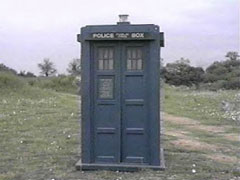 TARDIS is
the acronym for Time And Relative Dimension (or Dimensions) In Space.
It was the name given by the Time Lords to their space-time travel capsules.
Under normal conditions, a TARDIS looked like a blank, non-descript
cabinet with a door. However, it was immensely larger inside than
outside due to its transdimensional nature.
TARDIS is
the acronym for Time And Relative Dimension (or Dimensions) In Space.
It was the name given by the Time Lords to their space-time travel capsules.
Under normal conditions, a TARDIS looked like a blank, non-descript
cabinet with a door. However, it was immensely larger inside than
outside due to its transdimensional nature.
The space inside a TARDIS could be manipulated, expanded or reduced, according to the wishes of its owner. This factor apparently caused most weapons to become non-functional inside, although there were some exceptions to the above rule.
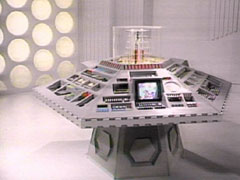 A
TARDIS was, in theory, virtually invulnerable to outside attacks, although
it could be turned invisible, imprisoned in a force field, hijacked from
the space-time vortex or otherwise captured. A TARDIS was equipped
with multiple defense systems, including the ability to dematerialize
and rematerialize after its attacker was gone (WW).
A
TARDIS was, in theory, virtually invulnerable to outside attacks, although
it could be turned invisible, imprisoned in a force field, hijacked from
the space-time vortex or otherwise captured. A TARDIS was equipped
with multiple defense systems, including the ability to dematerialize
and rematerialize after its attacker was gone (WW).
A chameleon circuitry enabled it to change its outside appearance, in order to blend in safely with its environment. Somehow, the TARDIS then acquired certain properties of the object it mimicked, including size and weight, since TARDISes were at times stolen, moved or transported by outside forces, a hard enough task, as it was once reported that the Doctor's TARDIS, under Earth gravity conditions, weighed (10x10) power 5 kilos.
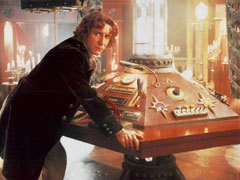 In theory, nothing, or no one,
could enter a TARDIS without either being invited in, or having a key
(a trionic device or an old-fashioned one). It has
been theorized that a TARDIS was semi-sentient, gifted with rudimentary
empathic qualities. Indeed, the Doctor's TARDIS sometimes appeared
to act of its own volition to alert its master to a grave danger, using
its "Cloister Bells" (C,
5V, 5Z).
In theory, nothing, or no one,
could enter a TARDIS without either being invited in, or having a key
(a trionic device or an old-fashioned one). It has
been theorized that a TARDIS was semi-sentient, gifted with rudimentary
empathic qualities. Indeed, the Doctor's TARDIS sometimes appeared
to act of its own volition to alert its master to a grave danger, using
its "Cloister Bells" (C,
5V, 5Z).
Among the substances a TARDIS needed to run properly are: mercury (B), Zyton-7 (6V) and artron energy (4P). In order to become fully operational, a TARDIS had to be primed by a Time Lord, whose bodies contained a symbiotic nucleus (the "Rassilon Imprimature") which enabled them to achieve molecular stabilization and a quasi-symbiotic control of the TARDIS (6W).
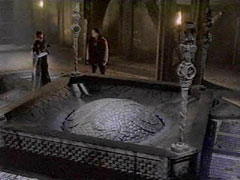 Other components which were part
of a TARDIS were the time rotor (located at the center of its control
console); a dematerialization circuit; a time vector generator; a quantum
accelerator, a temporal limiter and a dynomorphic regenerator.
Other components which were part
of a TARDIS were the time rotor (located at the center of its control
console); a dematerialization circuit; a time vector generator; a quantum
accelerator, a temporal limiter and a dynomorphic regenerator.
The Doctor's TARDIS was an old Type 40 (of which 305 were originally registered by the Time Lords), with isomorphic controls, meaning that, in theory, it could only be operated by the Doctor.
The Doctor's TARDIS was allegedly being repaired on Gallifrey when the Doctor 'borrowed' it. Its chameleon circuit was stuck, leaving its outside shape permanently frozen in the form of a London Police Box, except briefly one time when the Doctor managed to repair it (6T).
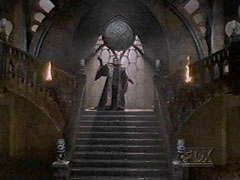 The Doctor's TARDIS' steering mechanism
was known to be faulty and behave erratically, although possibly not as
often as the Doctor claimed. When the Time Lords exiled the Doctor
to Earth (ZZ), they took away his TARDIS'
dematerialization circuit, but returned it after the Omega crisis (RRR).
The Doctor's TARDIS' steering mechanism
was known to be faulty and behave erratically, although possibly not as
often as the Doctor claimed. When the Time Lords exiled the Doctor
to Earth (ZZ), they took away his TARDIS'
dematerialization circuit, but returned it after the Omega crisis (RRR).
To escape from the Black Guardian, the Doctor equipped his TARDIS with a Randomizer (5F), but eventually disposed of it on Argolis (5N).
Some of the features of the Doctor's TARDIS included: two control rooms, the main one and the wood-paneled secondary one (4M), the Zero Room (5Z), the Cloisters, whose bell served as an alarm system (5V), a swimming pool, a power station disguised as an art gallery (4Z), a large boot cupboard (4M), and various guest rooms.